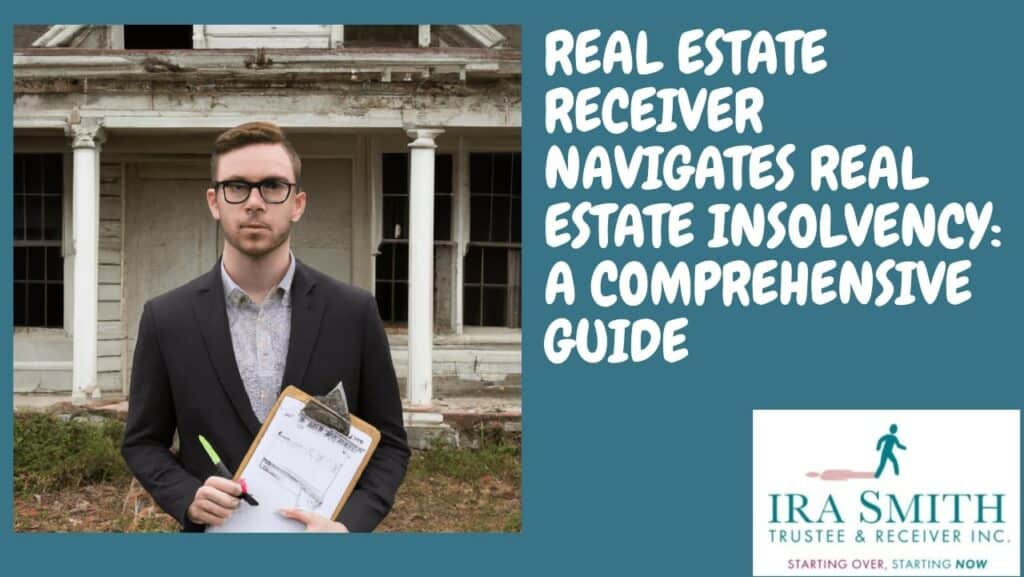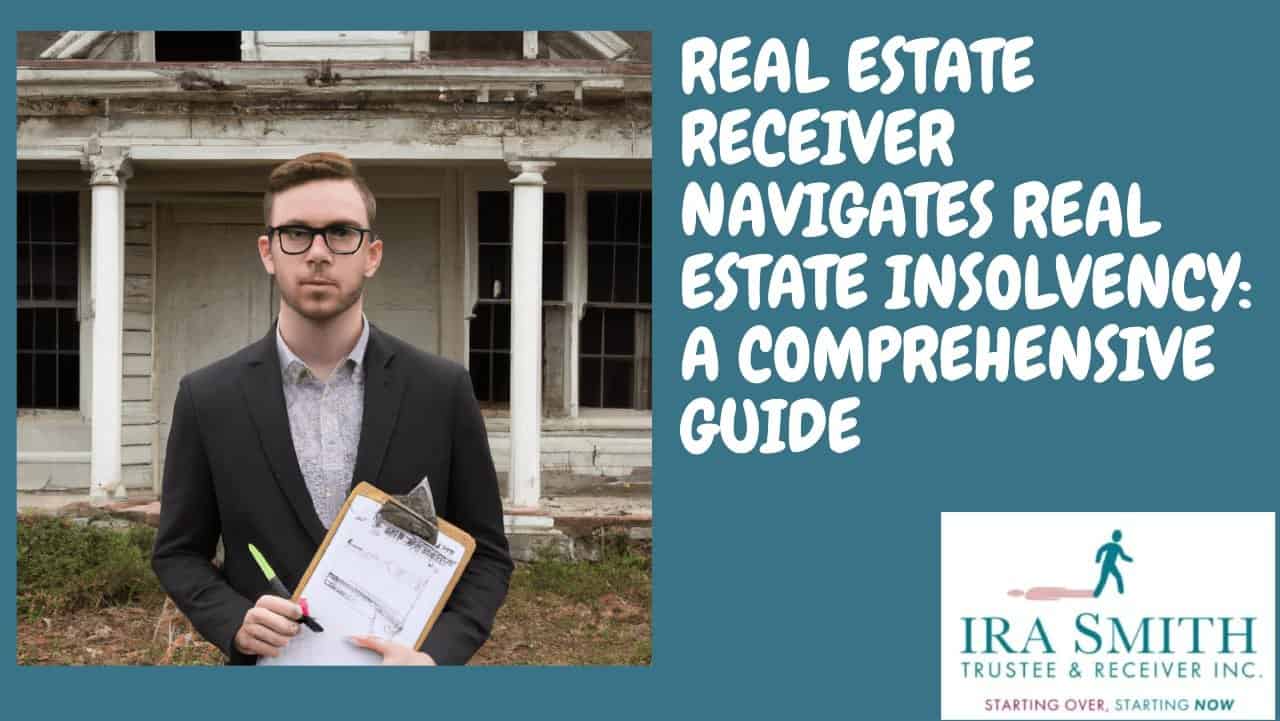Real Estate Receiver Introduction to Real Estate Insolvency
Commercial real estate markets are constantly evolving, and with the recent upswing in defaulted real estate loans on commercial properties, lenders and borrowers are facing unprecedented challenges. I have observed the current market conditions from our ongoing real estate receiver files with keen interest. The landscape is evolving, presenting both challenges and opportunities for developers, lenders and real estate investors alike.
In this Brandon’s Blog post, from my perspective as a real estate receiver, I delve into the intricacies of the growing sector of real estate insolvency, offering (hopefully) valuable insights for both owners and lenders. This includes the challenges faced by developers, the growing demand for remedies in distressed properties, and the overall market dynamics. Join me as I explore the remedies available to navigate through these turbulent times.
Real Estate Receiver Overview of the Current Market Conditions
The real estate sector is currently navigating through dynamic market conditions that have been shaped by various factors. The recent upswing in defaulted commercial real estate loans serves as a signal of a continued downward trend in the market cycle. Developers, especially those with ongoing residential condominium projects, find themselves particularly vulnerable to unexpected upheavals.
Challenges Faced by Developers with In-Progress Projects
Developers face challenges during the construction phase. Delays, spiking costs, and inflation in construction expenses have eroded profit margins, leading to financial strains on developers.
- Developers of residential real estate typically need to presell a significant portion of units to secure financing.
- Construction cost inflation and pandemic-related disruptions have further complicated project economics.
- Delays in construction schedules have been a common occurrence.
Developers in the real estate market are struggling with unprecedented challenges, with many facing insolvency issues. Adapting to changing market conditions and mitigating financial risks has become paramount. Legal experts note a growing demand for remedies across all types of distressed properties, highlighting the urgency in finding solutions to support developers and real estate investors.
Developers must navigate these challenges effectively by exploring various options such as mezzanine lending, private lending, and workout agreements. The evolving market dynamics require a proactive approach to address financial distress and ensure the successful completion of projects.
Growing Demand for Remedies in Distressed Properties
The growing demand for remedies in distressed properties underscores the need for collaborative efforts between lenders and borrowers to resolve defaults. Workout agreements and restructuring of loans offer potential solutions to mitigate financial risks and stabilize projects facing insolvency.
“It’s essential to establish trust and cooperation between borrowers and lenders to navigate through financial challenges effectively.”
Partnerships such as the conversion of mezzanine loans into equity demonstrate innovative approaches to address insolvency issues and support project completion. By exploring alternative solutions, stakeholders in the real estate sector can work towards sustainable outcomes and mitigate potential losses.

Real Estate Receivership: Challenges in Residential Condominium Economics
In my role as a real estate receiver, I am intrigued by the complexities of residential condominium project economics, particularly in the face of obstacles such as construction delays and escalating costs. These variables can substantially affect the financial viability of such projects, necessitating developers to implement targeted risk mitigation strategies.
Impact of Construction Delays and Cost Inflation
One of the most critical aspects affecting condo projects is the occurrence of construction delays and cost inflation. During the construction phase, when financing is fixed, any delays can lead to financial strain as developers cannot generate income until the project’s completion. Typically, developers aim to presell a significant percentage of units to secure financing. However, the recent spike in construction costs, coupled with delays, has eroded profit margins.
- Statistics Canada reported substantial inflation in construction costs.
- Delays in project timelines can lead to increased expenses and reduced profitability.
- Preselling units becomes challenging when costs cannot be accurately predicted.
Strategies for Developers to Mitigate Financial Risks
Developers facing these challenges must consider various strategies to safeguard their investments and navigate through uncertain economic conditions. Some effective risk mitigation strategies include:
- Diversifying funding sources to reduce dependency on a single financing option.
- Implementing robust project management techniques to minimize delays and cost overruns.
- Engaging in transparent communication with stakeholders to manage expectations effectively.
- Conversion of mezzanine loans into equity.
Real Estate Receiver: Power of Sale vs. Foreclosure Process
When it comes to handling defaulting real estate loans, there are various legal mechanisms available to lenders and borrowers to manage real property insolvency situations effectively without the need for a real estate receiver. In this section, I will compare the processes of power of sale and foreclosure, explore key scenarios where each approach may be beneficial, and discuss the legal considerations that both lenders and borrowers need to take into account.
Comparison of Power of Sale and Foreclosure Processes
Both power of sale and foreclosure are methods that lenders can use to recover funds from defaulted borrowers. The key difference between the two lies in the execution and outcome of the process.
- Power of Sale: This approach allows lenders to sell the property without involving court proceedings. It is authorized under Ontario’s Mortgages Act and is generally faster and less costly compared to foreclosure. Lenders have the right to sell the property to recoup the outstanding debt, with any surplus earnings returned to the borrower and any shortfall being the responsibility of both the borrower and any guarantors of the borrower’s mortgage financing.
- Foreclosure: In a foreclosure action, lenders take ownership of the property in exchange for the debt owed. This process involves court proceedings, starting with a statement of claim issued by the creditor. Foreclosure can be challenged by the borrower, and in some cases, the court may convert it to a judicial sale, allowing other parties to benefit from any potential surplus proceeds.
Key Scenarios for Each Approach
The choice between the power of sale and foreclosure may depend on the specific circumstances of the defaulting loan and the goals of the lender or borrower.
- Power of Sale: This method is often preferred when quick action is required to recover funds. It is suitable for situations where the market value of the property is likely to cover the debt, and lenders want a faster resolution.
- Foreclosure: Foreclosure may be more appropriate when the debt exceeds the property value, or when disputes regarding the validity of a sale are likely. Turning foreclosures into judicial sales provides added oversight and protection for borrowers, allowing for a fair distribution of proceeds.
Legal Considerations for Lenders and Borrowers
Both lenders and borrowers need to navigate various legal requirements and considerations when dealing with the power of sale and foreclosure processes.
- Lender Responsibilities: Lenders must adhere to statutory and contractual obligations, including providing notification to borrowers and ensuring fair market value in property sales. They have the right to pursue borrowers for any remaining debt after the property sale.
- Debtor Rights: In cases of insolvency, borrowers have the right to contest the sale and request evidence of its legitimacy. They may insist that lenders provide proof that the sale price accurately reflects the property’s true market value, supported by appraisals and appropriate marketing efforts.
The decision between utilizing the power of sale and pursuing foreclosure should be based on the specific circumstances of the defaulted loan, the characteristics and interests of all involved parties, and the desired outcomes for both lenders and borrowers. A comprehensive understanding of the variances and consequences associated with each approach is essential for effectively navigating insolvency scenarios within the real estate sector.

Real Estate Receiver: Workout – The Collaborative Solution
As a real estate receiver, I believe it’s crucial to understand the various mechanisms available to address mortgage defaults and insolvency in addition to a real estate receivership enforcement action in dealing with real estate assets. One such approach that has traction in the right circumstances in dealing with a real estate distressed asset is the concept of workouts as a collaborative solution to resolving defaults. Let’s delve into the key components of a workout plan and forbearance agreements.
Exploring the Concept of Workouts as a Collaborative Approach
When creditors and debtors face insolvency or defaults, engaging in a workout plan can offer a mutually beneficial solution. Unlike traditional enforcement measures like foreclosure or power of sale, workouts emphasize collaboration and finding a middle ground that works for both parties. This approach is based on trust, cooperation, and a shared goal of resolving financial difficulties.
Key Components of a Workout Plan and Forbearance Agreements
A workout plan typically involves amending the original loan agreement or creating a forbearance agreement to outline the terms and conditions for resolving the default. It requires a thorough assessment of the situation, a solid plan to address the financial issues, and a commitment to openness and transparency between the borrower and lender. By setting clear objectives and timelines, both parties can work towards a viable solution that avoids costly legal proceedings.
Real Estate Receiver: A Detailed Overview of a Real Estate Receivership
When comparing receivership with judicial sales and foreclosure processes, it becomes apparent that each approach has its unique advantages and challenges. Receivership, often court-appointed, involves a licensed insolvency trustee acting as the receiver overseeing the property’s recovery and sale to recoup funds owed. While more time-consuming and costly than the power of sale or foreclosure, court-appointed receivership offers a structured way to handle complex real estate insolvencies. Due to the complexity, a real estate receiver requires extensive powers from the court.
Challenges and benefits arise for both lenders and borrowers in the realm of receivership. Lenders may face the risk of insufficient property sale proceeds, prompting the pursuit of borrowers for remaining loan amounts. On the flip side, borrowers have the legal right to challenge the validity of a power sale and must ensure the property’s sale price reflects its market value to protect their interests.
Receivership serves as a court-supervised controlled process that aims to maximize gross sales proceeds and prioritize creditors’ claims transparently and efficiently. By applying to the court to appoint a receiver to handle property recovery and distribution, the complexities of insolvency can be managed effectively, safeguarding the interests of all stakeholders involved.
What is a receivership and how does it function in Canada’s legal framework?
Within the legal landscape of Canada encompassing matters of commercial contention, there is the intricate notion of receivership. This process entails the designation of one of the two types of receivers; either a privately-appointed receiver or a court-appointed receiver. A receiver is vested with the authority to assume dominion over a business’s array of assets and properties. This authority arises from situations of monetary default on their secured loans.
It is prudent to retain awareness that the role of a receiver can only be filled by a licensed trustee for assuming the mantle of a receiver within the confines of Canada’s legal expanse.
The fulcrum upon which the inception of the receivership mechanism pivots is usually the inability of secured creditors to recoup their financial outlay from a debtor, who in turn is incapacitated in discharging its pecuniary obligations.
The receiver becomes vested with the possession and control of the assets, affects their liquidation, and subsequently allocates the ensuing sale proceeds among the cadre of creditors within the hierarchy delineated by the legal ladder of priority of claims. A court-appointed real estate receiver may also need to retain other real estate experts such as property managers, appraisers and real estate agents.
As an instrumental constituent of the commercial legal architecture in Canada, the receivership process endeavours to safeguard the vested interests of both creditors and debtors. It offers creditors the avenue to recoup either the entirety or a portion of their outstanding amounts due.
Concurrently, beleaguered commercial entities are afforded the prospect of either orchestrating a financial reconfiguration that extricates them from the quagmire of their fiscal problems or facilitating the divestiture of assets with the aspiration of facilitating the uninterrupted continuity of the business, but under new ownership. It, therefore, emerges as an indispensable instrument within the gamut of the Canadian legal paradigm, upholding the equilibrium of economic constancy.
Who is an approved buyer in the context of a receivership sale?
In the detailed context of a receivership sale, an approved buyer describes an individual or entity that has effectively met the specific requirements stated by the designated receiver. These standards encompass a variety of variables, including financial disclosure, a shown understanding of the sale’s terms and conditions, and the tried and tested capacity to finalize the purchase quickly. Usually, the recognition of an approved buyer takes place within a defined bidding procedure, in which potential purchasers compete to meet these developed requirements.
Once identified, an approved buyer ends up being subject to the terms and terms laid out within the sale arrangement. It is the receiver’s responsibility to ensure that the sale is carried out with a commitment to fairness and transparency. This consists of the duty to pick an approved buyer who not only can efficiently wrap up the real estate transaction but also can enhance the overall value of the assets that are being sold.
The fiduciary responsibility of the receiver is paramount throughout this process. The receiver is obliged to act in the very best interests of all parties, which encompasses lenders and other stakeholders. For that reason, the receiver’s duty surpasses the simple identification of an approved buyer; it includes securing the integrity of the sale, guaranteeing fairness for all parties, and ultimately maximizing the value that can stem from the assets being sold within the context of the receivership.
The role of secured creditors and their rights in receiverships
In the world of Canadian receiverships, secured creditors play an essential function in identifying the destiny of troubled companies. Recognizing their rights is essential in going through this complex landscape. Secured creditors have the legal authority to take enforcement proceedings against the assets covered by their security and have a higher priority in payment contrasted to unsecured creditors. They can either privately appoint or apply to the court for the appointment of a receiver.
The court-appointed receiver acts as a neutral party in charge of taking care of and selling the assets. The secured lenders have the right to challenge court-approved buyers if they think the receivership sale process is unfair or if they have a better deal. Nonetheless, safeguarding their legal rights within receiverships calls for a detailed understanding of the legal complexities and efficient timing associated with receiverships.
A secured creditor plays a crucial duty in the sale process. As the main financial stakeholder given their claim against the secured assets, the secured creditor has a vested interest in the result of the sale procedure. The court-appointed sale procedure includes the marketing and sale of the debtor’s assets and properties, which inevitably establishes the amount of funds that will be available to pay against the secured debt.
For that reason, the secured lender has a significant interest in guaranteeing that the sale procedure is conducted in a way that optimizes the recuperation of funds. The secured creditor’s beneficial interest in the sale procedure is shown in their capability to approve or reject the sale of assets in a private appointment and carries a level of weight with the court for a court-approved sale. This power allows them to protect their economic interests and ensure the very best feasible result from the sale process.
The timelines and stages of a receivership sale: The role of the approved buyer in Canadian receiverships
In Canadian receiverships, the role of the approved buyer is essential to the successful outcome of a receivership. In a court-appointed receivership, approved buyers are court-approved purchasers who typically offer the highest and most beneficial bid for the debtor company’s assets. They play a crucial role in maximizing the value of the distressed company and ensuring the best outcome for all parties involved. Their timely participation in the receivership process is instrumental in achieving sale finality and ultimately shaping the fate of the distressed entity.
In the world of Canadian receiverships, the involvement of court-approved buyers functions as a cornerstone in supporting an equitable and clear process. This essential process makes certain that every interested party can take part in the bidding process for the assets being sold. The result of this bidding process finishes with the choice of the best overall bidder. This mechanism of operation is rooted in concepts of justness, striving to eliminate any type of unnecessary benefit that a solitary party might have over others.
When a company is placed into receivership, the assigned receiver assumes command over the assets as well as operational elements of the business. The purpose behind the orchestration of a receivership sale revolves around the liquidation of the firm’s holdings to get them out of the insolvent troubled company and into the hands of a buyer who can maximize their value. The timing and stages integral within receiverships have a level of fluidity depending upon the intricacy and complexity of the business’s operations and assets.
Generally, the receiver’s starting point is the meticulous groundwork and strategy in setting up the sale procedure. Typically, the initial stage involves the preparation and marketing of the sale of the assets. This is followed by the negotiation and acceptance of offers from interested parties. In court-appointed receiverships, once an offer is accepted, the sale is subject to court approval and then the transfer of ownership is completed.
As this complex process unravels, the receiver must follow rigid lawful as well as regulatory requirements, thereby promoting an environment of impartiality and transparency that emphasizes a fair sale process. In its totality, the underlying purpose of a receivership sale opens up as the optimization of the company’s asset values, a pursuit carried out in the service of all stakeholders’ well-being.

Real Estate Receiver: What the Court Requires To Approve A Real Estate Receivership Sale
Being involved as a bidder in real estate receivership sales can be both exciting and daunting, laden with unique challenges and opportunities. Let’s delve into the intricacies of what the Court requires for the legal process to approve a particular sales process and sale of assets when the company is in receivership.
The Soundair principles
The Soundair principles are a collection of lawful standards developed by the Court of Appeal for Ontario in 1991 in the case of Royal Bank of Canada v. Soundair Corp., 1991 CanLII 2727 (ON CA). All Canadian courts follow these principles.
The Soundair principles are aimed at creating fairness and transparency in the sale of assets throughout real estate receivership cases. Thirty-one years later, it is still the leading case in Canadian insolvency asset sales rules and regulations. These concepts guide courts in evaluating whether the sale procedure carried out by a receiver has been fair and suitable.
Here are the Soundair principles in detail:
- Diligent Efforts to Secure the Best Price: The receiver/trustee is obliged to exert sensible efforts to secure the highest possible price for the assets for the general benefit of creditors. This entails thoroughly advertising the assets for sale, soliciting competing bids, and ensuring that prospective purchasers have sufficient information to submit proper offers to purchase. The goal is to get the highest sales price possible under the circumstances, to maximize the return for the benefit of creditors.
- Fairness and Integrity in the Sale Process: It is essential to give all interested parties an equivalent opportunity to join the sales process and to avoid any potential purchaser from obtaining an unreasonable edge. Transparency and impartiality are vital, and conflicts of interest cannot be tolerated.
- All Stakeholders’ Interests: The receiver/trustee must look out for the interests of all parties, secured creditors and unsecured creditors, shareholders, and any other appropriate stakeholders. It is very important for the licensed insolvency trustee to avoid preference for any party and to strive for a fair equilibrium of the interests among everybody affected because the company is insolvent.
- Input from significant creditors: This is a crucial consideration for the licensed insolvency trustee. While the trustee retains the ultimate decision-making authority, it is essential to carefully weigh and consider the recommendations and preferences of major creditors. Given that these creditors will bear financial implications based on the sale outcomes, their input carries substantial significance in the decision-making process.
Application of the Soundair principles
In practice, when a sale of assets is held because the company is in receivership, there are two stages of court review. First, the licensed insolvency trustee needs to get approval for the actual sales process itself. Then, the Court will review the process as implemented by the licensed insolvency trustee.
The Court’s reviews are to ensure conformity with these Soundair principles. This is the case if this is not a sale at arm’s length purchaser. The court will take into consideration the following elements:
- Marketing Efforts: How the assets were advertised and marketed, including the period and reach of the advertising and marketing initiatives.
- Number and Quality of Offers: The variety of offers obtained and whether they reflect reasonable market price. To assist the Court in determining the reasonableness of the offers received, the Trustee must provide evidence to the Court. An independent appraisal of the assets and other market data is the normal kind of evidence usedwhat a fair valuation of the assets is.
- Transparency: Whether the sale process was conducted fairly and transparently, with appropriate details provided to all possible purchasers.
- Stakeholder Consultation: Whether the licensed insolvency trustee has spoken with and taken into consideration the views of significant creditors and other stakeholders.
- Authorization of Sale: Whether the proposed sale is supported by the significant creditors or as a minimum, is not being opposed.
The Soundair principles assist when a company is in receivership, in guaranteeing that the sale of assets in an insolvency context is carried out in a fashion that maximizes value, keeps fairness, and appreciates the interests of all the major stakeholders. By adhering to these concepts, the court aims to supply confidence in the integrity and fairness of the process and protect the rights of all stakeholders.
Real Estate Receiver FAQs on Real Estate Receivership and Insolvency
- What is a Real Estate Receiver? Answer: A real estate receiver is a court-appointed licensed insolvency trustee individual or firm responsible for managing, operating, and sometimes selling a property that is in financial distress. The receiver acts as a neutral third party to preserve the value of the property for the benefit of creditors and stakeholders.
- What is Real Estate Insolvency? Answer: Real estate insolvency occurs when a property or the owner of a property is unable to meet financial obligations. This often leads to legal proceedings where creditors seek to recover owed amounts, potentially resulting in foreclosure or receivership.
- When is a Receiver Appointed in Real Estate Cases? Answer: A receiver is typically appointed when a property is in financial distress, and there is a risk of losing significant value. This can occur during foreclosure proceedings, bankruptcy cases, or other situations where the property’s income and management are compromised.
- What Are the Duties of a Real Estate Receiver? Answer: The responsibilities of a real estate receiver encompass overseeing the daily activities of the property, collecting rental payments, maintaining the property, facilitating required repairs, and occasionally coordinating the property’s readiness for potential sale. The primary objective of the receiver is to optimize the property’s value and uphold equitable treatment of all stakeholders.
- How Does the Receivership Process Work? Answer: The receivership process commences upon the issuance of a court order appointing a receiver. The receiver assumes control of the property, evaluates its condition, and executes a management strategy. Regular reports are submitted to the court, and the receiver adheres to the court’s instructions until the property is stabilized, sold, or resolved in another manner.
- What Are the Benefits of Appointing a Receiver? Answer: Appointing a receiver offers numerous advantages, including the stabilization of distressed properties, prevention of waste and loss, and provision of a neutral party to impartially manage the property. This can prove highly beneficial to creditors, owners, and tenants alike, safeguarding the property’s value and potentially optimizing its worth.
- Can Property Owners Regain Control of Their Property After Receivership? Answer: Yes, property owners can regain control of their property if they resolve the financial issues and the court approves the termination of the receivership. This often requires paying off debts, restructuring finances, or meeting other conditions set by the court.
- What Happens to Tenants During Receivership? Answer: Tenants generally continue their leases under the receivership. The receiver collects rents and manages the property as usual, ensuring that the property remains operational. Tenants may experience improved management and maintenance under a receiver’s oversight.
- How Are Receivers Compensated? Answer: Receivers are compensated from the income generated by the property or from the proceeds of a property sale. Their fees and expenses must be approved by the court and are given priority over both secured and unsecured creditor claims by the court.
- What Is the Difference Between Receivership and Foreclosure? Answer: Receivership and foreclosure are distinct legal processes in real estate management. Foreclosure refers to a legal action taken by a lender to recover the outstanding loan balance from a borrower who has defaulted on payments, often leading to the sale of the property. On the other hand, receivership entails the appointment of an impartial third party to oversee and stabilize the property, to potentially prevent foreclosure, maintain the property’s value and ultimately sell it.
- Can a Receiver Sell the Property? Answer: Yes, a receiver can sell the property if authorized by the court. The sale process is usually supervised by the court to ensure it is conducted fairly and that the proceeds are distributed according to the court’s directives.
- What Challenges Might a Receiver Face? Answer: Challenges include dealing with neglected maintenance, unpaid taxes, existing liens, tenant disputes, and market conditions. The receiver must navigate these issues while adhering to legal requirements and court orders.
- How Long Does a Receivership Last? Answer: The duration of a receivership is contingent upon the intricacy of the case, the state of the property, and the objectives of the receivership. The timeline can range from several months to multiple years.
- Who Can Request the Appointment of a Receiver? Answer: Interested parties such as creditors, lienholders, property owners, or other relevant entities have the option to seek the appointment of a receiver. The court will evaluate such requests by taking into account the specific circumstances and the necessity of safeguarding the property’s value.
These FAQs provide a comprehensive overview of key concepts related to real estate receivership and insolvency.
Real Estate Receiver Conclusion
I hope you have enjoyed this real estate receiver Brandon’s Blog. Do you or your company have too much debt? Are you or your company in need of financial restructuring? The financial restructuring process is complex. The Ira Smith Team understands how to do a complex restructuring. However, more importantly, we understand the needs of the entrepreneur or the person who has too much personal debt.
You are worried because you are facing significant financial challenges. It is not your fault that you are in this situation. You have been only shown the old ways that do not work anymore. The Ira Smith Team uses new modern ways to get you out of your debt troubles while avoiding bankruptcy. We can get you debt relief freedom.
The stress placed upon you is huge. We understand your pain points. We look at your entire situation and devise a strategy that is as unique as you and your problems; financial and emotional. The way we take the load off of your shoulders and devise a plan, we know that we can help you.
We know that people facing financial problems need a realistic lifeline. There is no “one solution fits all” approach with the Ira Smith Team.
That is why we can develop a restructuring process as unique as the financial problems and pain you are facing. If any of this sounds familiar to you and you are serious about finding a solution, contact the Ira Smith Trustee & Receiver Inc. team today.
Call us now for a free consultation. We will get you or your company back on the road to healthy stress-free operations and recover from the pain points in your life, Starting Over, Starting Now.
The information provided in this Brandon’s Blog is intended for educational purposes only. It is not intended to constitute legal, financial, or professional advice. Readers are encouraged to seek professional advice regarding their specific situations. The content of this Brandon’s Blog should not be relied upon as a substitute for professional guidance or consultation. The author, Ira Smith Trustee & Receiver Inc. as well as any contributors to this Brandon’s Blog, do not assume any liability for any loss or damage resulting from reliance on the information provided herein.







